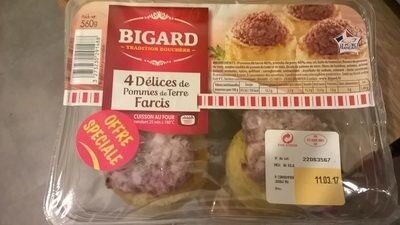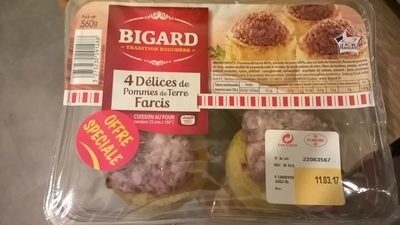Délices de pomme de terre farcies, BIGARD, 4 pièces - 560 g
This product page is not complete. You can help to complete it by editing it and adding more data from the photos we have, or by taking more photos using the app for Android or iPhone/iPad. Thank you!
×
Barcode: 3273230291488 (EAN / EAN-13)
Quantity: 560 g
Brands: Bigard
Categories: Meats and their products, Meals, Meals with meat, Beef dishes, Refrigerated foods, Refrigerated meals
Labels, certifications, awards:
French meat, French pork, Green Dot, Nutriscore, Nutriscore Grade B
Origin of ingredients: France
Manufacturing or processing places: France
Traceability code: EMB 47032B - Bon-Encontre (Lot-et-Garonne, France), FR 47.032.001 CE - Bon-Encontre (Lot-et-Garonne, France)
Countries where sold: France
Matching with your preferences
Environment
Packaging
Transportation
Report a problem
Data sources
Product added on by kalepom
Last edit of product page on by packbot.
Product page also edited by beniben, kiliweb, openfoodfacts-contributors, quechoisir, roboto-app, sebleouf, yuka.CbpcG_OVMusmFsf2_toRwxK3EvXnDdxbH2cvow, yuka.L-pFNdywEsNxF8r74dwa5ha_L9nPG68GICE8og, yuka.WVpzcVQ0bGNvOFFQa2ZZaHprejE2K040bjRLdmNXNllKZUJPSUE9PQ, yuka.YXFjU0lMVUhpLzh0dDhObi95TDgzdllxbTUyQWZscXljY2s4SVE9PQ, yuka.sY2b0xO6T85zoF3NwEKvllVNeuKAuAP1DT_TqxO09vSDLrbUaMtfyKnDOas.









